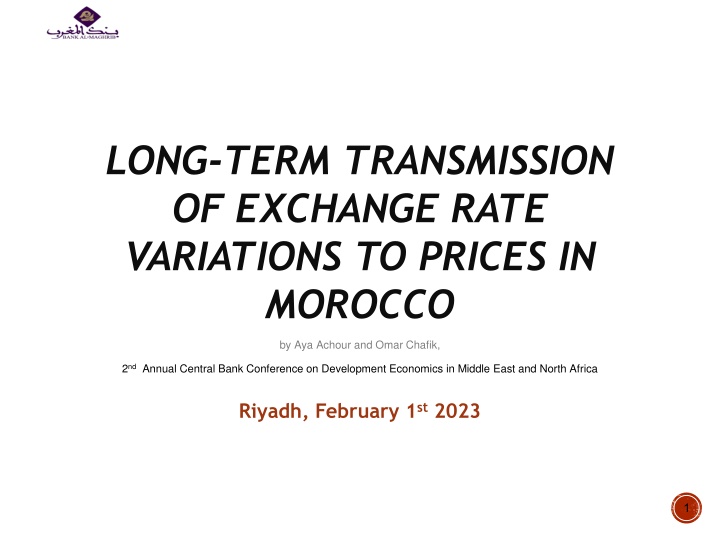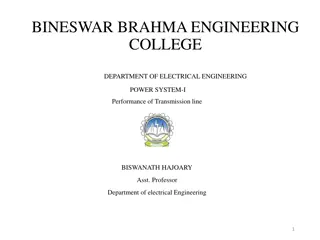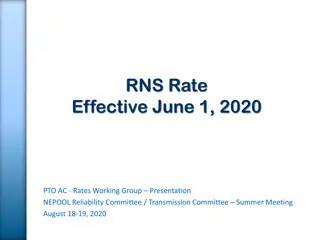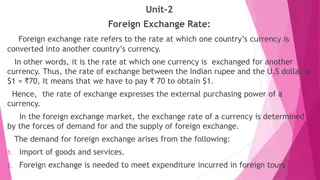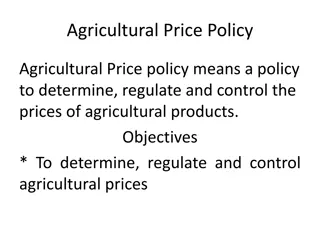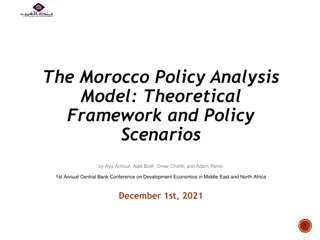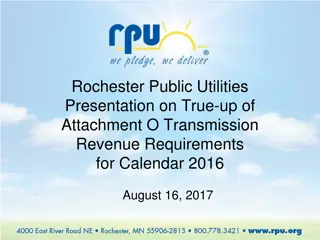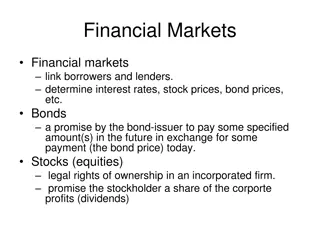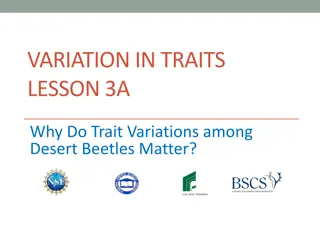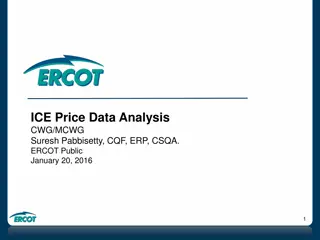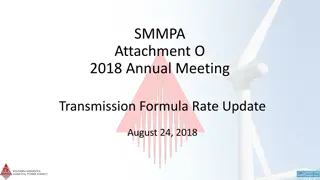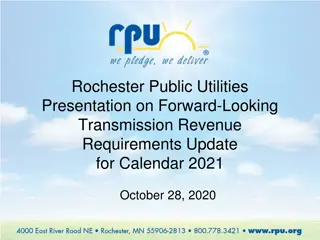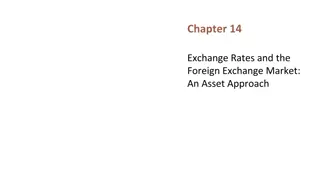Long-Term Transmission of Exchange Rate Variations to Prices in Morocco
The study explores the relationship between exchange rate movements and prices in Morocco, focusing on the exchange rate pass-through (ERPT) concept. It investigates the impact of exchange rate fluctuations on inflation and price stability, particularly in the context of a transitioning economy like Morocco. By employing various methodologies and analyzing data from 1990 to 2019, the research aims to provide updated estimates of ERPT amplitude to prices in the long run, considering specific factors of the Moroccan economy. This study is pivotal for informing monetary policy decisions in Morocco amidst recent economic changes.
Download Presentation

Please find below an Image/Link to download the presentation.
The content on the website is provided AS IS for your information and personal use only. It may not be sold, licensed, or shared on other websites without obtaining consent from the author.If you encounter any issues during the download, it is possible that the publisher has removed the file from their server.
You are allowed to download the files provided on this website for personal or commercial use, subject to the condition that they are used lawfully. All files are the property of their respective owners.
The content on the website is provided AS IS for your information and personal use only. It may not be sold, licensed, or shared on other websites without obtaining consent from the author.
E N D
Presentation Transcript
LONG-TERM TRANSMISSION OF EXCHANGE RATE VARIATIONS TO PRICES IN MOROCCO by Aya Achour and Omar Chafik, 2ndAnnual Central Bank Conference on Development Economics in Middle East and North Africa Riyadh, February 1st2023 1
Introduction In a small, open economy like Morocco that depends on external trade, the exchange rate plays a fundamental role in price-setting behaviour and economic growth. In the wake of greater exchange rate flexibility and gradual capital account liberalization, the relationship between exchange rate and inflation is deemed more pronounced and likely more complex. More recently, prices has skyrocketed to unprecedented levels, prompting concerns for large domestic currency depreciation that could intensify the inflationary pressures. This surge in inflation may also create a vicious circle which leads to further price increase, likely to compromise price stability. Investigating the degree of transmission of exchange rate movements to prices becomes an imperative for the formulation and the conduct of monetary policy, particularly for a transitioning country like Morocco This relationship between the exchange rate and inflation is among the most studied topics in the field of international economics (Burstein and Gopinath, 2014). It is referred to as the exchange rate pass-through (ERPT) concept. 2 18/09/2024
Introduction In Morocco, some studies have estimated the degree of the exchange rate pass- through to domestic prices using a structural VAR methodology between 1990 and 2019. This working paper aims to provide a robust and updated estimate of the ERPT amplitude to prices in Morocco in the long run, using reduced-form and structural methodologies, while adapting them to key Moroccan economy specificities. In addition to applying different approaches, we also focus the analysis on the long- term link between the exchange rate and prices from the perspective of core consumer price and bilateral exchange rates of the dirham vis- -vis the main foreign currencies. To the best of our knowledge, our study is the first one to provide a thorough investigation of the exchange rate pass-through size in Morocco, following the liberalization of energy prices, the introduction of more flexible exchange rate regime and the outbreak of the recent Covid-19 pandemic. 3 18/09/2024
Methodology There is a wide empirical literature on the ERPT assessment. Among popular studies those based on reduced-form single equation framework (such as ARDL models) and structural VAR models. Referring to the studies of Aisen et al. (2021), Hong and Zhang (2016), Faryna (2016) and Delatte and Lopez (2011), we opt for an ARDL methodology which considers both external and domestic determinants of consumer prices in Morocco: (1) Where nominal effective exchange rate, Euro area, is the logarithm of the consumer price index, the logarithm of the the logarithm of the consumer price index in the the non-agricultural output the logarithm of the nominal interest rate and gap. , , correspond to the short-term elasticities of the explanatory variables, while 4 18/09/2024 up to represent the long-run elasticities.
Methodology Three additional model variants are also estimated, including core consumer price index instead of headline CPI and replacing nominal effective exchange by the bilateral exchange rates of the dirham against US dollar and Euro currencies: ARDL variant 1 ARDL variant 2 ARDL variant 3 5 18/09/2024
Methodology Despite the robustness of the ARDL model approach, it is based on the strong assumption that exchange rate variations are exogenous with respect to prices. To relax this assumption, we opt for a structural VAR methodology that allows us to account for the dual causality between exchange rate and prices, following McCarthy (2007), Hahn (2003), Choudhri et al. (2005) and Faruqee (2006). In line with these papers, we estimate a quarterly VAR with five variables, (consumer price index, nominal interest rate, nominal effective exchange rate, and non-agricultural GDP) and one exogenous variable relating to the consumer price index in the euro area. Although the empirical literature is dominated by the triangular simultaneity restrictions, we use an identification strategy based on long-run restrictions to incorporate our economic specificities (in line with Shambaugh (2008) and Forbes et al. (2018)) 6 18/09/2024
Results (ARDL approach) We estimate the aforementioned models on quarterly data spanning from 2007 Q1 to 2021 Q4. For the four ARDL models, we perform the Pesaran, Shin and Smith (PSS). F-statistics Estimation sample Model(1) (NEER) Model(2) (CPIX) Model(3) (USD/MAD) Model(4) (EUR/MAD) ARDL Models 2007 - 2021 T4 7,95 10,31 8,59 6,20 Yes Yes Yes Existence cointegration relationship of a Yes 1% Significance Level Source: Authors' calculations 1% 1% 1% The Wald statistic (F-statistics) supports the existence of a stable long-run relationship between consumer price and exchange rates for all the ARDL models 7 18/09/2024
Results (ARDL approach) Based on these estimates, it is possible to interpret the results of cointegration relationships from the four ARDL models. Table 5: Estimation of long-term coefficients and their p-value over the period 2007-2021 Q4 Model (1) Model (2) Model (3) Model (4) Variables (NEER) (CPIX) (USD/MAD) (EUR/MAD) (5,0,4,0) (2,1,4,4) (5,0,1,2,0) (Lags) (5,3,2,3) -0,33 -0,14 0,105 0,335 Exchange rates (0.037) (0.026) (0.004) (0.007) 0,34 0,33 0,43 0,61 Consumer price in the Euro area (0.015) (0.02) (0.0000) (0.000) -0,17 -0,09 -0,07 -0,08 Nominal interest rate (0.0003) (0.008) (0.001) (0.0003) Not significant Not significant Not significant -0,02 International prices oil (0.008) 8 Source: Authors' calculations 18/09/2024
Results (SVAR approach) Prior to estimating the VAR model, we consider the following long-run restrictions: Domestic supply Monetary shock Exchange shock policy rate Domestic demand Long-term restrictions IPC C(1) C(2) C(4) C(7) 0 Nominal interest rate C(3) C(5) C(8) 0 0 C(6) Nominal exchange rate effective C(9) 0 Non-agricultural GDP 0 0 C(10) Based on the above restrictions, the estimate of the structural VAR model between 2007Q1 and 2021Q4 leads to the long-term cumulative exchange rate pass-through to consumer prices of 33.3 percent. In other words, about one-third of the nominal effective exchange rate fluctuations are transmitted to domestic consumer prices. 9 18/09/2024
Evolution of ERPT post structural reforms and Covid-19 pandemic Following Gagnon and Ihrig (2004), we perform an estimation of the ERPT level on the sub-sample 2016Q1 to 2022Q2. The motivation behind this time period is to investigate the impact of the full liberalization of energy prices that occurred in December 2015, the transition to a flexible exchange rate regime reform starting from January 2018 the occurrence of the Covid-19 crisis. Long-term relationship and ERPT magnitude using the ARDL approach over the period 2016 Q1-2022 Q2 F-statistics Model(1) (1,1,1)) Model(2) (4,3,3) Model(3) (4,2,1) Model(4) (4,5,5) ARDL Models 7,77 2016 - 2022 7,83 6,66 8,44 Yes*** Yes*** Yes*** Existence cointegration relationship of a Yes*** -0,37 -0,21 (0.0054) 0,15 (0.0068) 0,375 (0.000) Exchange through to prices (p-value) *** 1% significance level rate pass- (0.01) 10 18/09/2024 Source: Authors' calculations
Evolution of ERPT post structural reforms and Covid-19 pandemic Exchange rate pass-through in Morocco estimates according to the SVAR approach Exchange rate pass-through to prices Estimation sample 2016 Q1-2021 Q4 -39,3% 2007 Q1-2021 Q4 -33,3% Source: authors' calculations Overall, the two methodological approaches are consistent in pointing out a slight acceleration in the long-run ERPT to consumer prices between 2016Q1 and 2022Q2. In order to test the robustness of these results, we build on the works of L pez- Villavicencio and Mignon (2016), Jasova et al. (2016), and Aisen et al. (2021), and proceed to the estimation of an augmented variant of the reduced-form ARDL model (equation (1)). This new model incorporates, in addition to the conventional determinants of inflation, the interactions between the exchange rate and these structural reforms/shocks. 11 18/09/2024
Evolution of ERPT post structural reforms and Covid-19 pandemic We add three respective dummy variables that take the value 1 after the economic reforms/Covid-19 pandemic. For prior dates, these variables are set to 0. rwise: 12 18/09/2024
Evolution of ERPT post structural reforms and Covid-19 pandemic Estimation of long-term coefficients and their p-value over the period 2007 Q1-2021 Q4 Model (3) Model (l) Model (2) Variables -0,20 -0,35 -0,285 Nominal effective exchange rate (0.029) (0.0066) (0.016) 0,53 (0.000) 0,45 0,34 Prices in the Euro area (0.000) (0.0012) -0,09 -0,14 -0,16 Nominal interest rate (0.0017) (0.000) (0.000) 0,0036 Exchange rate*Energy price liberalization reform ------------- (0.0045) -------------- 0,003 Exchange reform rate*Flexible exchange rate -------------- (0.033) --------------- --------------- ---------------- -0,006 Exchange rate* Covid-19 Pandemic (0.08) Source: Authors' calculations 13 18/09/2024
Conclusion In this paper, we provide a robust and updated estimate of the long run exchange rate pass-through amplitude between 2007Q1 and 2021Q4. Using a reduced-form methodology (ARDL models) and a structural VAR approach with long-run restrictions, our estimates reveal that the exchange rate pass-through to consumer price index is incomplete and its magnitude is estimated to be around 33 percent in the long run. The moderate size of the ERPT seems to be robust to different measures of consumer prices and exchange rate indicators. In terms of policy implications, a moderate long run exchange rate pass-through would help the Moroccan authorities to continue to stabilize inflation at low levels, which in turn is likely to reduce the exchange rate pass-through size to prices. For further stages of the FX reform in Morocco, a smaller exchange rate pass-through could limit the effects of economic shocks on growth and inflation and reduce their volatility. Our investigation was extended to understand the relationship between the exchange rate and inflation over the recent period, which is the period spanning from Q1 2016 to Q2 2022. 14 18/09/2024
Conclusion Estimates show a slight increase in the magnitude of exchange rate pass-through to consumer prices, from 33% in the overall sample to approximately 38% over the last years. We argue that this slight acceleration can be mainly attributed to : the removal of energy price subsidies which occurred lately in Morocco compared to the majority of emerging countries, the adverse effects of the Covid-19 pandemic which have weighed differently on price and exchange rate dynamics compared to the pre-crisis period and the persistent appreciation of the dirham since the transition to a more flexible exchange rate regime reform in January 2018, which is more likely to pass on to prices, would have affected the recent level of ERPT. We emphasize that the significant efforts made by the Central Bank of Morocco to ensure a successful reform to a more flexible exchange rate regime, in particular continuous communication with financial operators and firms, could help mitigating the effects of this reform on the ERPT amplitude. As these last conclusions depend on the small size of the data sample on which our estimates were based, regular updates of the exchange rate pass-through must be carried out in order to investigate possible structural breaks in its magnitude. 15 18/09/2024
THANK YOU FOR YOUR ATTENTION 16 18/09/2024
